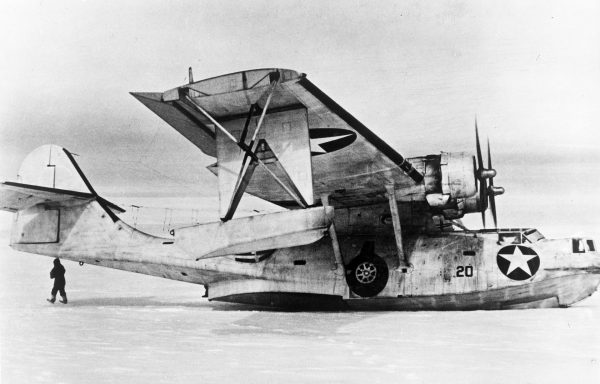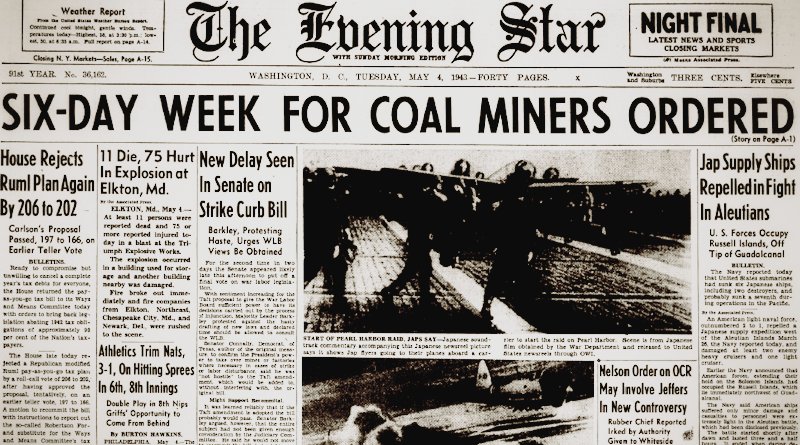World War II Chronicle: May 4, 1943
Click here for TODAY’S NEWSPAPER
The front page reports that Maj. Gen. Simon Bolivar Buckner Jr., the commanding general of Alaska Defense Command, is one of several officers who have been promoted. Buckner is a second-generation West Point grad (Class of ’08); Simon Sr. was a lieutenant general in the Confederate Army and petitioned Pres. Theodore Roosevelt for an appointment for his son. Pinning on a second star is Brig. Gen. William E. Kepner who currently heads 4th Interceptor Command. We wrote about Kepner in one of the earliest Chronicle posts…
No man left behind
Page nine tells of a months-long rescue operation to bring back a B-17 crew that crash-landed on Greenland. On Nov. 5, 1942 a Douglas C-53 Skytrooper1a C-47 modified to carry paratroopers was flying west along the “Snowball Route” across the Atlantic when it crashed in Greenland. They radioed their position and team of rescuers from a nearby weather station set out on sleds. They were unable to locate the stranded airmen, who were never heard from again.
Other aircraft ferrying across the Atlantic were routed over the location of the crash site, including a B-17F flown by Capt. Armand L. Monteverde. They ran into clouds which obscured the rising terrain. Monteverde’s wing struck the terrain and the Fort crashed into the ice. Meanwhile, a Douglas DB-7 Boston2the export version of the A-20 Havoc belonging to the Royal Air Force also hit the deck nearby, but its Canadian crew was quickly rescued by the U.S. Coast Guard.
The B-17’s radio operator eventually got his plane’s radios working again and hailed the nearby weather station, who dispatched more aircrews to search the area. On Nov. 28 they were located the marooned bomber and the weather station’s motorized sled crews set out again into the howling winds and sub-zero temperatures. A Grumman J2F-4 Duck from Coast Guard Cutter Northland — the same vessel that rescued the Canadians — soon landed on the ice cap. Hiking a mile to the crash site, they returned with two of the wounded men from the B-17 and flew back to the cutter.
On the next day the Duck returned and took the radio operator with him. The sled team — or what was left of it since one man plunged into a deep crevasse in the ice — had reached the stranded men. The Duck ran into a winter storm and was never heard from again. The ground element didn’t fare much better; one man fell to his death in a deep crevasse and the other sled died. The surviving rescuers were now stuck as well.
In December a Canadian airplane was lost when flying into the stiff Arctic winds used up all the fuel. The rescue crew managed to hike out and reach an Eskimo village. On Jan. 27 a Coast Guard PBY Catalina was lost when it hit the ground in terrain that it couldn’t take back off from. Finally on Feb. 5 a PBY led by Col. Bernt Balchen, a Norwegian-born polar explorer now serving in the Army Air Force, lands near the B-17 and extracts all but three members. After dropping off a sled team to reach the Fort, which took several days to get there and back from the landing zone, the “Cat” comes back on April 5, but blows an engine. Catalina floats are designed for floating on water, not scraping across ice caps, and due to their weight has to leave the rescuers behind.

Balchen leads the team across the Arctic terrain and they finally arrive at Beach head Weather Station on April 16. Five-and-a-half months in temperatures so cold and wind so tough you probably don’t even remember what it was like to feel warm. The men were kept alive by airdropped supplies. Greenland’s weather and poor visibility had claimed seven airplanes during the operation and three men gave their lives. But Americans don’t leave a man behind.
Many of the details were left out for brevity and because, unless you have lived through anything like what these men endured, you can’t possibly understand what it’s like to be so extremely cold and miserable for months on end. There’s likely not much to keep your mind off the gale-force winds and your freezing extremities when you’re camped out in the tail section of a broken bomber. Ever been in a B-17? If not, it’s smaller than you think. You have to wonder which was worse: the putrid, malaria-ridden jungles in the Solomons or the frozen hell that is Greenland in winter? There are probably plenty of Marines that served in Greenland a couple of years ago that could answer that since they experienced both…
George Fielding Eliot column on page 10… Sports section begins on page 14, which mentions the different baseballs that the National League is using. Maybe you haven’t heard of the “balata” ball, but Major League owners sure have. And they have been working hard with Spalding to get around the problems that arise when the Nazis control the source of the hide and the Japanese control the rubber. Sports Illustrated has a great article explaining the ball drama of 1943… “Torpedo 8” continues on page 32…
Roving Reporter by Ernie Pyle
NORTHERN TUNISIA (By Cable) — Another friend whom I’ve mentioned before in these columns is now among the missing. He too we know almost definitely is a prisoner.
He is Capt. Tony Lumpkin, of Mexico, Mo. Tony was headquarters commandant of a certain outfit — a headquarters commandant being a sort of militarized hotel manager.
Just before he disappeared Tony got to going by the nickname of “Noah” Lumpkin, because he always seemed to pick out such a miserably wet place for a command post. On their last move before he was captured, the commanding general — a swell guy with a sense of humor — called Lumpkin over, stood with him outside a tent looking out over the watery landscape, and congratulating him on locating them in the center of such a beautiful lake.
Tony Lumpkin needn’t have been captured at all if he had been content to stick to his comparatively safe “hotel managing.” But he wanted to get a crack at the Jerries himself. He is an expert gunner, and he finally talked the commander into letting him take five men and a small gun on wheels and go out to see what he could pick off.
The first day they got one German truck plus something that turned out later to be a camel, although it looked like a truck from the distance they were firing from.
The second day they moved farther into the mountains to get into a better shooting position, but bagged nothing that day.
On the third day they went even farther into the hills, hunting a perfect spot for firing.
Captain Lumpkin used to share a tent with Maj. Chuck Miller of Detroit and with their assistant, Corp. William Nikolin of Indianapolis, both of whom I’ve written about before. They formed an intimate little family.
That third night Major Miller came in late. He was astonished, and a little bit concerned to see Tony’s cot empty. When he woke up next morning there was still no Tony.
He knew something had happened. He went to the general and got permission to start out with a squad of his own military police to hunt for his lost companion.
They covered all the ground Tony had covered, and finally, by studying the terrain and talking with others who had been near by, and interviewing German prisoners, they pieced together what had happened. The hill that Captain Lumpkin had been trying to get to had simply been lousy with German machine-gunners. The Germans saw him all the time. They sent out a party that worked behind and surrounded him. A German who was captured later said that a captain with a Tommy gun killed one German and wounded another before being taken. That is all we will know until Tony comes back to us.
There isn’t grief in the little Lumpkin-Miller-Nikolin family, but there is a terrible vacancy.
“We were a perfect team,” Major Miller says. “Tony was slow and easygoing, and I’m big and lose my temper too quickly. We balanced each other. I’d keep him up and he’d calm me down. We sure miss him, don’t we Nicky?”
The two who remain, the officer and the corporal, seem drawn even closer than before. When there are guests Nicky is called in to be part of the company. Nicky waits on the six-foot-four major as though he were a baby, and the major treats Nicky with an endearing roughness.
Major Miller went on:
“Nicky always woke us up every morning by bringing in hot tea. Then the damned intellectual would ruin the day for me by sitting down while we drank the tea and starting an argument along the line of who was the greater writer, Tolstoy or Anatole France. That kind of stuff throws me.
Tony would argue with him, and believe me of the horror of such a subject at such an hour. But that Tony’s gone I have to bear the load all by myself. It’s awful.
And Nicky stands and grins while the major talks.
Our conversation drifted off onto other things, and a long time afterwards, out of a clear sky, Major Miller said:
“Damn it. I’d give a month’s pay — no, I’d give six months’ pay if only Tony were back.”
And Nicky would gladly do the same.
Ernie’s friend Capt. Tony B. Lumpkin, the former commandant of the Missouri Military Academy in Mexico, Mo., was in fact captured by the Germans. Sent to Officierlager 26 in Poland, he escapes in March 1945.
Evening star. (Washington, D.C.), 4 May 1943. Chronicling America: Historic American Newspapers. Lib. of Congress.
https://chroniclingamerica.loc.gov/lccn/sn83045462/1943-05-04/ed-1/
